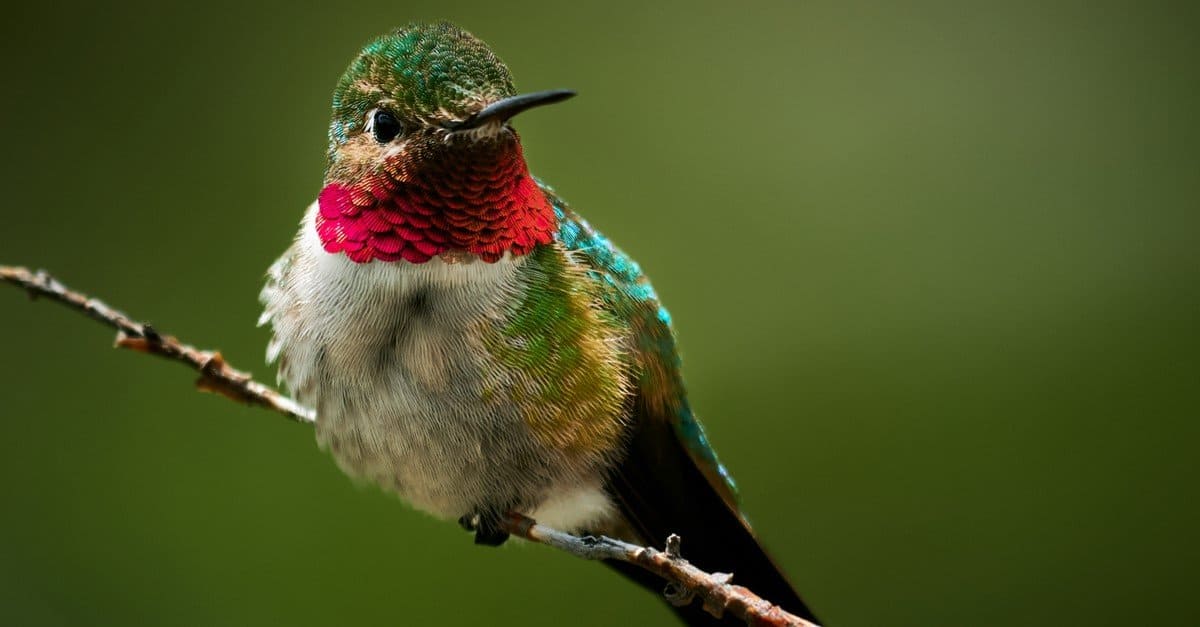Welcome to our blog post on hummingbirds in Colorado! In this article, we will delve into the fascinating world of these enchanting creatures and explore the various types of hummingbirds that call Colorado their home.

5 Hummingbirds in Colorado
The hummingbirds of Colorado are a fascinating and vibrant group of migratory birds that captivate the hearts of nature enthusiasts. These delicate creatures embark on incredible journeys, with their wintering grounds located in Mexico between September and April. However, it is during the months of April to August that these enchanting birds grace the United States with their presence.
Because Anna’s hummingbird, broad-billed hummingbird, and white-eared hummingbird are very rare sitings in Colorado, we left them out of this article. But they do deserve honorable mention, as you can occasionally spot them as they migrate through the state.
Black-Chinned Hummingbird

One of the most beautiful sights to see in the garden is a black-chinned hummingbird.
©rck_953/Shutterstock.com
The black-chinned hummingbird (Archilochus alexandri) is a small species of bird that lives in western North America. It breeds from southern British Columbia, southeastern Alberta, and central Saskatchewan south through the United States from California to Texas and south into Mexico. In winter, it migrates to the southern parts of its range and to Central America.
The black-chinned hummingbird builds its nest in trees and shrubs, usually in deciduous woods or along streams. The nest is cup-shaped, made of plant fibers, moss, and spider webs, and lined with feathers and fur. Female hummingbirds construct their nests 6–12 ft above the ground.
The black-chinned hummingbird is around 4 in long, with an average wingspan of 6 in. Females are green above, and grayish-white below with a black chin and throat, and males are green above and grayish-white below with a purple throat and a black chin. Both sexes have a white spot in front of their eyes, and the male also has a white stripe on its wings. They have long, thin, straight bills and short, forked tails.
Ruby-Throated Hummingbird
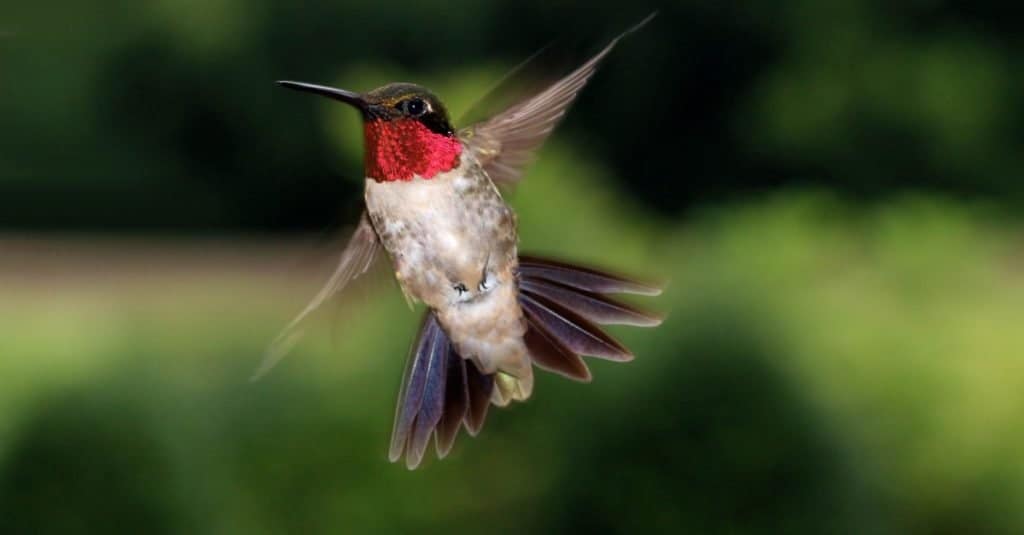
Male ruby-throated hummingbirds have a red throat, while females have a white one.
©Ramona Edwards/Shutterstock.com
The ruby-throated hummingbird (Archilochus colubris) is a species of hummingbird that has a wide range, from eastern Canada and the eastern United States south to Nicaragua. It is the only hummingbird species that breeds east of the Mississippi River in the United States.
These small birds are easily recognizable due to their distinct appearance. They have a metallic green back and crown, a white throat and chin, and a forked tail. The males have a ruby-red throat patch, while the females have a white throat.
Ruby-throated hummingbirds nest in a variety of habitats, including deciduous and coniferous forests, swamps, meadows, and suburban areas. The female builds the nest alone, using spider webs, lichen, moss, and other materials. The nest is cup-shaped and is typically placed in a small tree or shrub.
The ruby-throated hummingbird is an active and agile flier, feeding on nectar and insects. They exhibit hovering behavior, where they can remain in the same spot for a few seconds while their wings beat rapidly.
Calliope Hummingbird

This tiny hummingbird is the smallest one in North America.
©MTKhaled mahmud/Shutterstock.com
The calliope hummingbird (Selasphorus calliope) is the smallest bird that lives in North America. It has a wide range, which extends from Alaska to Mexico, and breeds in most parts of the United States as well as in Canada. It is a migratory hummingbird in Colorado and southern Canada during the summer months.
The calliope hummingbird typically builds its nest in coniferous forests, such as pine and spruce trees. They make their nests out of downy plant material, moss, and spider webs, which they bind together with spider silk.
The calliope hummingbird is a colorful species of hummingbird. The male has a glossy green head, back, and throat, with a pinkish wash on the throat. The wings and tail are blackish-green, while the belly is white. The female is duller in color, with a gray head, back, throat, and white belly. Both sexes have a reddish patch on the throat.
The calliope hummingbird is a small species, measuring only 3-4 inches in length and weighing just a few grams. It has short and rounded wings and a tail with a notch at the end. It has a long, thin, curved bill, which it uses to feed on nectar from flowers.
The calliope hummingbird is an active species, often seen hovering in mid-air while it feeds. It also has a distinctive flight pattern, with a rapid fluttering of its wings as it darts from flower to flower.
Broad-Tailed Hummingbird
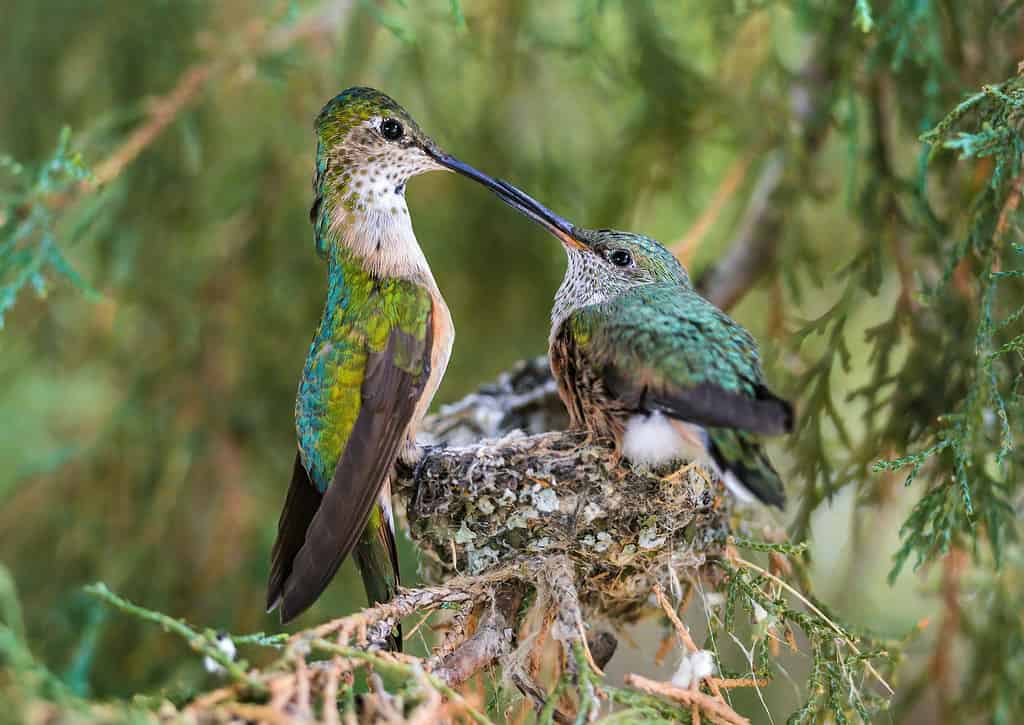
Females have dull green plumage on their back and wings, with a whitish-gray breast and belly.
©Susan Hodgson/Shutterstock.com
The broad-tailed hummingbird (Selasphorus platycercus) is a species of hummingbird that lives in the western United States and Mexico. It migrates up to 4,000 miles each year in search of nectar-rich flowers to feed on.
The broad-tailed hummingbird typically builds its nest in trees or dense shrubs, usually in areas near bodies of water. They build their nests from plant fibers, spider webs, and other materials and line them with feathers.
The broad-tailed hummingbird is a small bird with a body length of only 3-3.5 inches. It has a white throat and chest, a green back and tail, and a broad, reddish-brown tail. The male has a bright red gorget, while the female has a white one. Its wings are short, and its bill is slender and slightly curved.
Rufous Hummingbird

Male rufous hummingbirds have bright-colored plumage and a reddish-orange face.
©Keneva Photography/Shutterstock.com
The rufous hummingbird is a small, colorful hummingbird in Colorado. Its breeding range is quite large, stretching from southeastern Alaska to northern California and east to western Montana, Idaho, and Nevada. In winter, they migrate south to southern California, Arizona, and New Mexico.
In terms of appearance, the rufous hummingbird is about three inches long with a bright orange-red throat and breast, a white belly, and a green back. Its wings are a deep green, while its tail is a rusty reddish-brown with white tips.
Nesting sites for the rufous hummingbird are typically in woodlands, forests, meadows, and gardens. They prefer to nest in areas with dense vegetation and plenty of nectar sources nearby. The rufous hummingbird builds a small cup-shaped nest out of bark, twigs, and moss, which they place in a tree branch or shrub.
9 Plants to Attract Hummingbirds in Colorado
There are dozens and dozens of plants that are attractive to hummingbirds that will grow well in Colorado. Here are a few of our favorites!
Scarlet Beebalm (Monarda didyma)
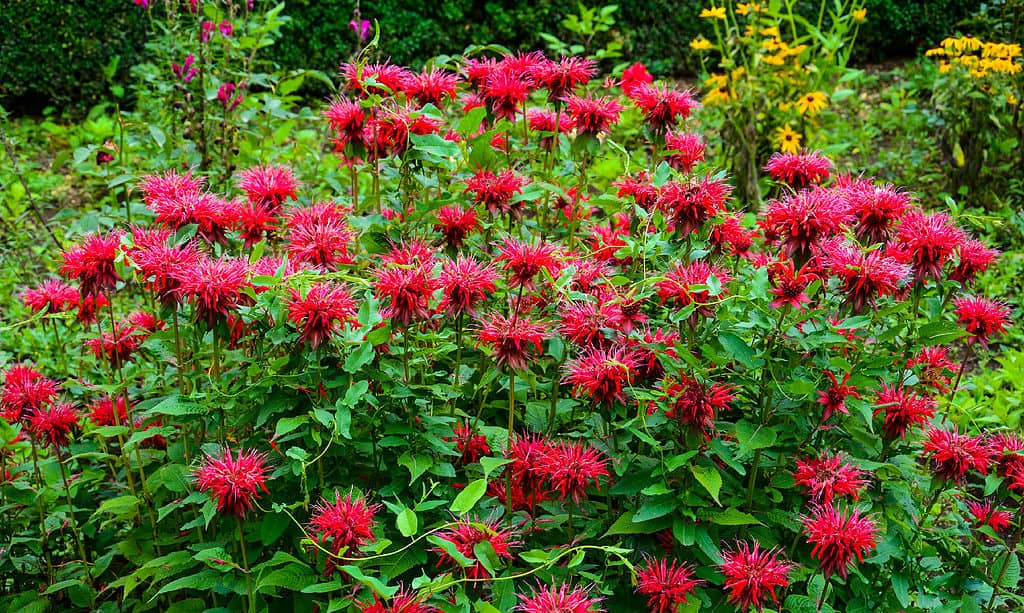
This hummingbird attractor features ovate to ovate-lanceolate deep green leaves with serrated margins.
©Vahan Abrahamyan/Shutterstock.com
Scarlet beebalm is a stunning perennial, flowering plant that blooms in the late spring and early summer. Its showy, vibrant flowers are a bright, reddish-orange color and have a distinct tubular shape. Hummingbirds pollinate these flowers because they love the sweet nectar.
The plant itself is an upright perennial, growing up to three feet in height. Its leaves are dark green and lance-shaped with a pointed tip. When in bloom, the flowers form in clusters at the top of the plant, resembling a shower of red petals.
Scarlet bee balm grows best in full sun and is known for its drought tolerance. It is a popular choice for wildflower gardens, as it is often the first to bloom in the spring. It is also attractive to other pollinators, including butterflies and bees.
Overall, scarlet beebalm is an attractive and low-maintenance plant that is attractive to hummingbirds in Colorado. Its bright, showy blooms are sure to bring life and color to any garden!
Fireweed (Epilobium angustifolium)
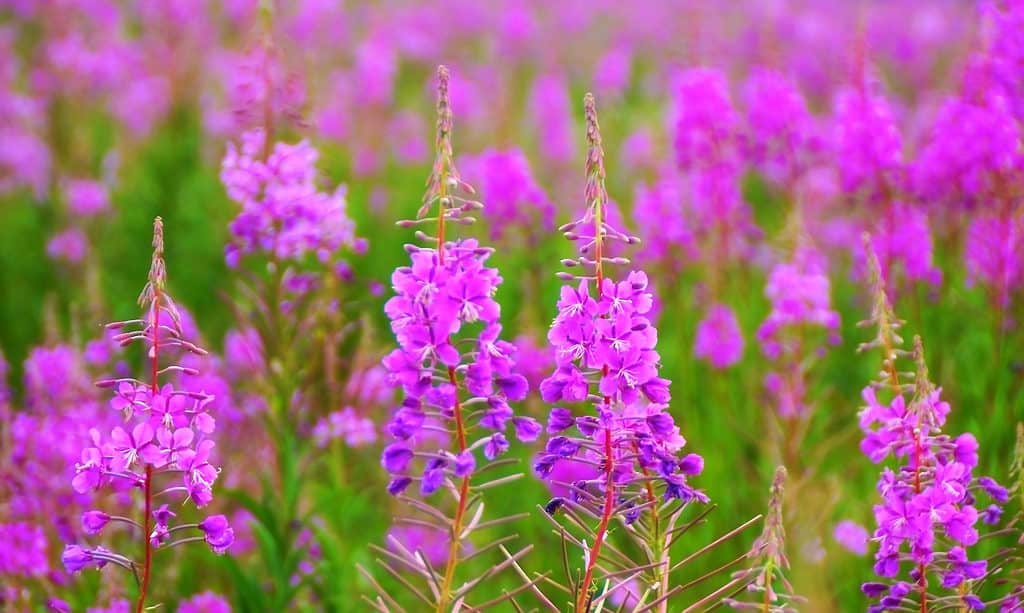
Hummingbirds love the sweet nectar of fireweed.
©Real Moment/Shutterstock.com
Fireweed is a perennial wildflower native to North America and Europe. It is a tall, slender plant with a height of up to 8 feet. It has narrow, lance-shaped leaves that are pale green to reddish-green in color. Its blooms are beautiful and showy, growing in clusters of pink, purple, or white flowers with four petals.
Fireweed blooms in late summer and early fall, making it a great addition to a garden. It is a bee-friendly plant with nectar-rich flowers that attract hummingbirds and other pollinators. Its flowers are also a great source of food for birds and other wildlife.
The attractive clusters of flowers make it a popular choice for flower beds and garden borders. You can also grow it in containers, and it makes a great cut flower for floral arrangements. Fireweed is also a great choice for naturalizing, adding color and texture to any landscape.
In addition to its attractive blooms, Fireweed is also very hardy and easy to care for. It tolerates a variety of soils and can handle both sun and shade. It also doesn’t require much in the way of fertilizing or pruning and is drought-tolerant.
With its showy blooms and ability to attract hummingbirds and other wildlife, Fireweed (Epilobium angustifolium) is a great choice for any garden. Its beautiful clusters of flowers bloom in late summer and early fall, and its hardiness and low maintenance make it a great addition to any landscape.
Trumpet Honeysuckle (Lonicera sempervirens)

Lonicera sempervirens in full bloom are a delicious treat for pollinators.
©shepherdsatellite/Shutterstock.com
Trumpet honeysuckle is a luscious, deciduous shrub native to the United States. It reaches heights of up to 10 feet and is recognizable by its bright green, ovate-shaped leaves. In the spring, trumpet honeysuckle produces clusters of fragrant, orange-red flowers that are up to 4 inches long. These flowers bloom from late May to early June and are especially attractive to hummingbirds in Colorado. The flowers are followed by small, black berries in late summer. The trumpet honeysuckle is a low-maintenance shrub, making it a popular choice for landscaping. It is also highly attractive to a variety of wildlife, making it an excellent addition to any garden.
Wild Columbine (Aquilegia caerulea)
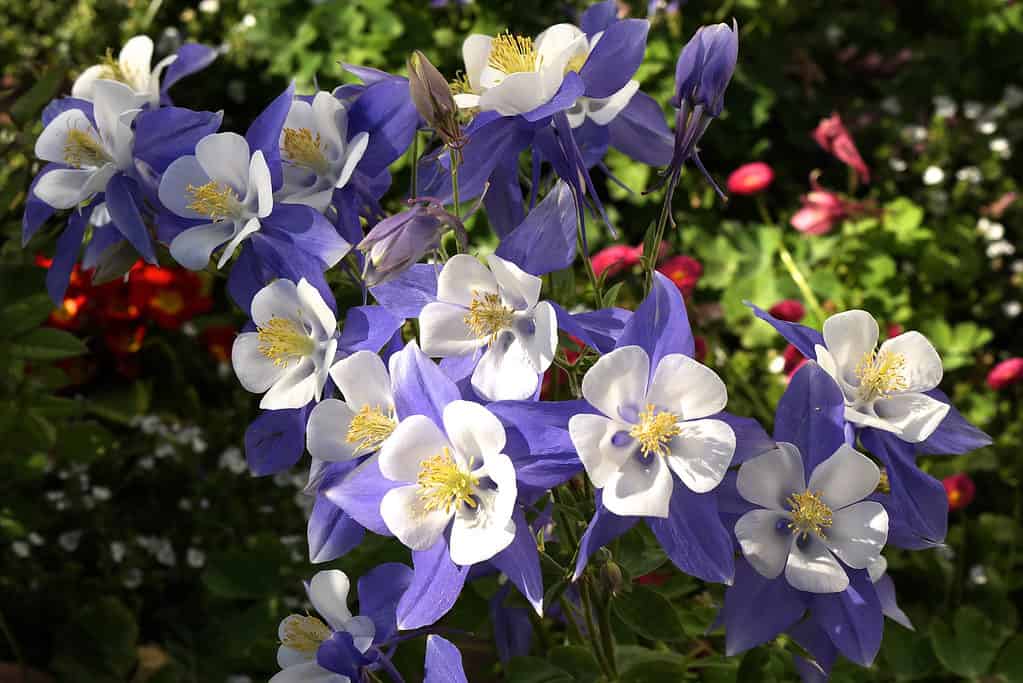
Colorado blue columbine (Aquilegia caerulea) grows well in the state of Colorado.
©iStock.com/Linda Jo Heilman
Wild columbine is an attractive perennial herbaceous plant featuring delicate, fan-shaped foliage and blue and white bell-like flowers. It grows up to two feet tall and blooms in the spring and early summer months.
The showy flowers of wild columbine have five petals, each with a distinctively curved shape. The upper petal is blue, and the four lower petals are white with a hint of blue. The flowers also feature long spurs at the back.
Wild columbine is attractive to hummingbirds in Colorado thanks to its tubular-shaped flowers, which provide a convenient source of nectar. Its sweet nectar also attracts other pollinators, such as butterflies and bees.
Penstemon (Penstemon spp.)
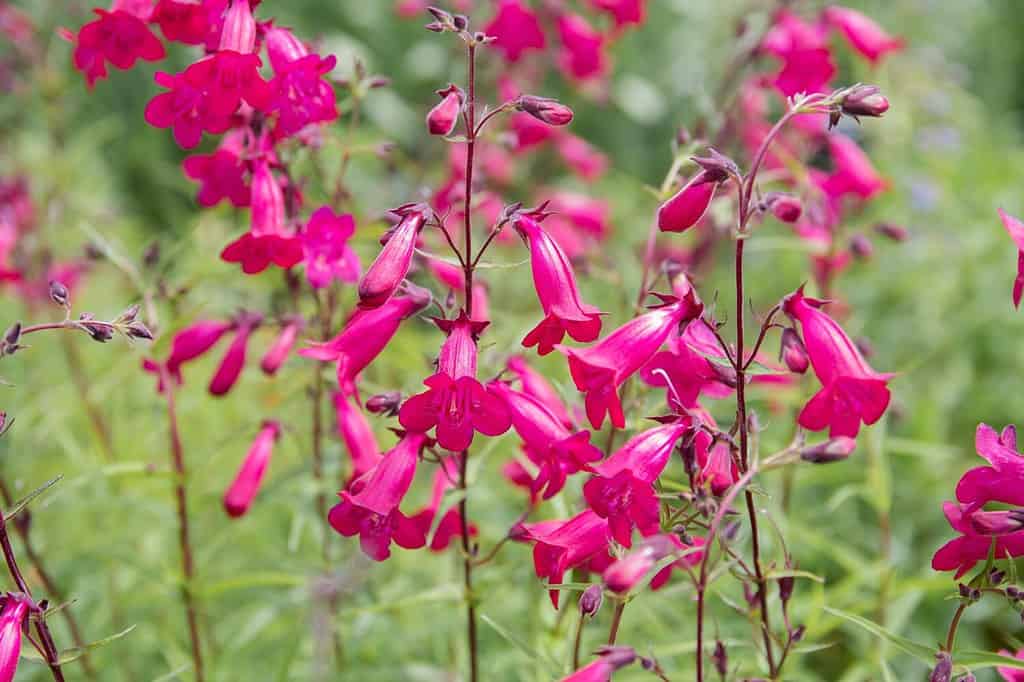
Clusters of bluestem penstemon will brighten up your garden and attract hummingbirds.
©litts/Shutterstock.com
Penstemon (Penstemon spp.) is an attractive perennial flower that grows in a variety of colors, including pink, purple, and white. It has an eye-catching tubular shape with five-lobed petals and long, slender leaves. It typically blooms in the summer months, and its nectar-rich flowers make it an attractive source of food for hummingbirds.
The flowers of penstemon are typically two to three inches long and range in color from deep purples and pinks to white. Its foliage is a bright, vibrant green, and its leaves are long and narrow.
Penstemon typically blooms in the summer, with flowering beginning in late spring and continuing through the summer. It is a resilient plant and can survive in both warm and cold climates.
Hummingbirds are especially attracted to penstemon, as it provides a rich source of nectar for them to feed on. Its long, tubular shape makes it easy for them to access the nectar, and the bright colors of its flowers make it stand out in a garden.
Greenleaf Manzanita (Arctostaphylos patula)

The flowers of Manzanita are a hummingbird favorite.
©iDiscoverer/Shutterstock.com
Greenleaf manzanita (Arctostaphylos patula) is an evergreen shrub with a dense, mounding growth habit. Its trunk and branches are covered in a smooth, reddish-brown bark, and its bright green leaves have a leathery texture. It produces clusters of urn-shaped, white flowers in late winter to early spring, and these flowers are a popular source of nectar for hummingbirds. Its attractive, bright green foliage and fragrant flowers also make it a desirable garden plant. Greenleaf manzanita is an excellent choice for adding year-round structure and color to gardens.
Creeping Barberry (Mahonia repens)

This type of barberry produces yellow flowers that hummingbirds like.
Creeping barberry (Mahonia repens) is an evergreen shrub with a mounding and spreading habit. It grows up to 1 foot tall and has bright green, glossy leaves with a holly-like shape. In spring, it produces yellow flowers that look like tiny clusters of stars. These flowers are very attractive to hummingbirds as they provide a plentiful source of nectar. Creeping barberry blooms from March to May with white, blue, or purple berries that appear in late summer.
Overall, creeping barberry is an attractive, low-maintenance shrub that provides year-round interest. It is a great choice for gardeners looking for a low-growing, evergreen shrub that can provide a food source for hummingbirds. Additionally, it is great for borders, mass plantings, and ground cover.
Hummingbird Sage (Salvia spathacea)
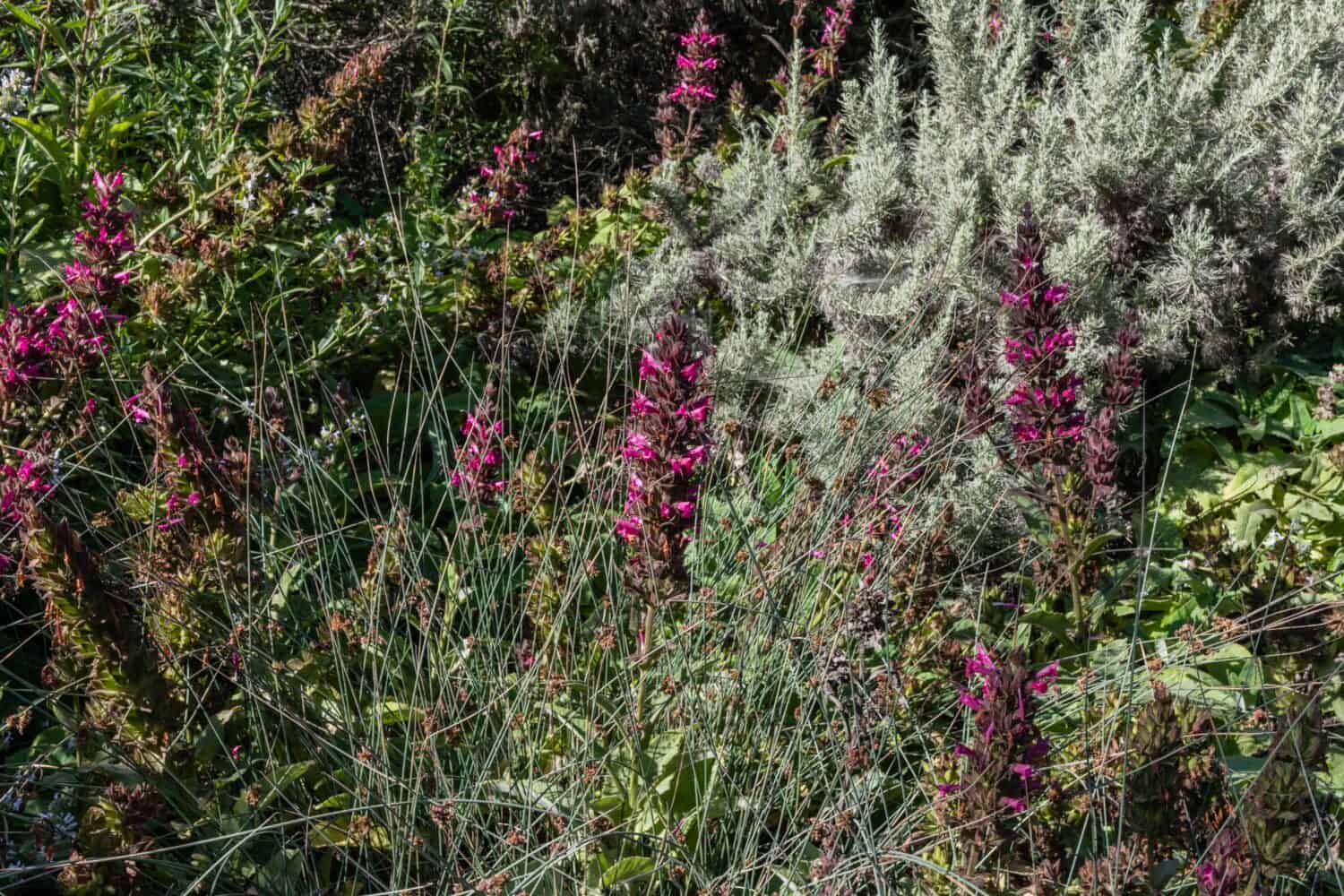
You can grow salvia spathacea as an annual to attract hummingbirds in Colorado.
©Alex Krassel/Shutterstock.com
Hummingbird Sage is an attractive flowering shrub that is native to California. It is attractive to hummingbirds because of its bright red flowers and long bloom period. It is a low-maintenance, drought-tolerant plant that is easy to grow. In cold climates, you can grow it as an annual. It has an aromatic scent that is similar to mint. The flowers are a striking red and will bloom for several weeks in late spring and early summer. Hummingbird Sage is an easy-to-grow plant that can bring a splash of color and attract hummingbirds to your garden.
Seep Monkeyflower (Mimulus guttatus)

This lovely yellow flower attracts many types of hummingbirds.
©Nick Pecker/Shutterstock.com
The seep monkeyflower is an attractive flowering plant that is native to North America. It is popular for its bright yellow, bell-shaped flowers and is a favorite of hummingbirds. It is a perennial plant that you can treat as an annual. Growing seep monkeyflower is easy as it requires little care and maintenance.
When in bloom, the seep monkeyflower is a stunning sight with its bright yellow flowers. The blooms are bell-shaped and slightly fragrant, with a delicate scent of honey. It is an excellent choice for gardens, especially those with a lot of shade. It is also an ideal choice for container gardening.
Seep monkeyflower is a great way to attract hummingbirds to your garden. Hummingbirds love its bright-colored blooms. If you plant it in the spring, you can enjoy its beauty all summer long. It also makes a great cut flower and can be used for flower arrangements.
Thank you for reading! Have some feedback for us? Contact the AZ Animals editorial team.

